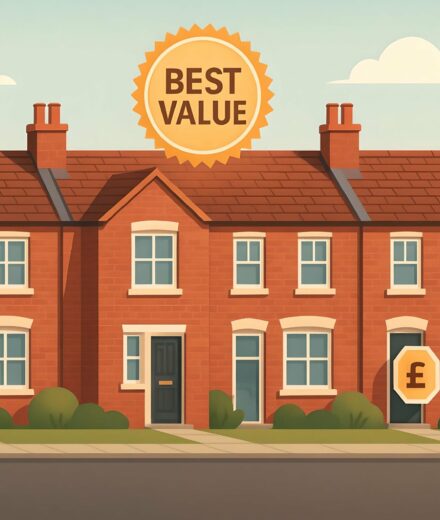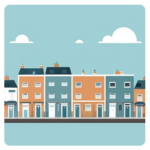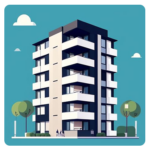

House Prices > Luton
| Year | Average Price | Transactions |
|---|---|---|
| 2025 (proj.) | £318,400 | 2,709 |
| 2024 | £307,100 | 1,868 |
| 2023 | £302,500 | 2,194 |
| 2022 | £301,400 | 2,988 |
| 2021 | £287,100 | 3,632 |
| 2020 | £278,300 | 2,233 |
| 2019 | £255,800 | 2,922 |
| 2018 | £248,000 | 3,128 |
Luton’s property market has been on the move, with average prices rising like an express train out of the town centre. If you’re watching for signs of momentum or hints of a slowdown, the numbers from the past several years paint a compelling picture. Here’s what stands out:
If you’re thinking of selling in today’s market, you might notice fewer buyers around the table than in the feverish days of 2021. Yet those buyers who do show up are often ready to pay more for the right property, especially in neighbourhoods that are rising stars on the local scene. At M0VE, we’ve seen desirable family homes in Luton’s leafier districts snapped up before the listings have even cooled down.
So, what can we establish? Price growth in Luton is remarkably resilient. Fewer properties may be changing hands, but values continue to push upwards, helped by robust demand and limited supply. If you’re weighing up your next move, or trying to maximise your sale, understanding how these trends affect your home’s worth is critically important. Have a read of our detailed guide: Luton Property Valuation Explained: How Much Could You Sell For? for fresh, actionable advice.
Searching for a place to settle? Luton has plenty of homes for sale that could suit you.

Avg. Property Price: £447,400
Avg. Size of Property
1,228 sq/ft
Avg. Cost Per Sq/ft
£379 sq/ft
Total transactions
1,134 (since 2021)

Avg. Property Price: £323,600
Avg. Size of Property
929 sq/ft
Avg. Cost Per Sq/ft
£362 sq/ft
Total transactions
3,374 (since 2021)

Avg. Property Price: £244,200
Avg. Size of Property
772 sq/ft
Avg. Cost Per Sq/ft
£327 sq/ft
Total transactions
3,076 (since 2021)

Avg. Property Price: £191,800
Avg. Size of Property
558 sq/ft
Avg. Cost Per Sq/ft
£349 sq/ft
Total transactions
792 (since 2021)
Luton’s property market remains as lively as a weekend on George Street, with real, pronounced differences across property types. Detached homes, perched at the top, have an average price which would make most house-hunters gulp, yet they offer notably spacious living for those with larger budgets. At the opposite end, flats are often the first port of call for young professionals or those seeking a compact base near the centre, but their smaller average size means the cost per square foot remains slightly punchy.
The number of recorded transactions for semi-detached and terraced homes far outstrips other property types, marching past their detached and flat counterparts by an impressive margin. This signals that Lutonians, in their thousands, are drawn to these more accessible property styles, possibly due to their blend of manageable upkeep and versatile layouts. For families considering the daily shuffle—school runs, park visits, and commutes—terraced and semi-detached homes seem to hit that sweet spot without sending wallets into freefall.
With purchase values of detached properties so much higher, it’s clear these are the preserve of those ready to invest in permanence and privacy. That said, the cost per square foot is not dramatically higher compared to other types, so for buyers focused on value-per-square-inch, the jump in outlay does come with proportionate benefit in living space. There’s a subtle echo here of that old Luton saying: big dreams are best matched by big front drives.
On the flipside, flats—though the least numerous by transactions since 2021—remain a crucial part of Luton’s market ecosystem. Their typically central locations and lower individual prices attract those climbing the first rungs of the property ladder. Still, in ultra-competitive areas, finding an affordable flat is like spotting an open seat on the Thameslink at rush hour: possible, but increasingly rare.
For those weighing up the best strategy, Luton Property Valuation Explained: How Much Could You Sell For? is a must-read for sharper context on how values evolve by property type.
| District | Avg Price (£) | Transactions |
|---|---|---|
| LU1 | £263,900 | 4,085 |
| LU2 | £294,200 | 6,866 |
| LU3 | £283,700 | 4,854 |
| LU4 | £270,000 | 3,307 |
Luton’s property market has always moved with a dynamic energy, but the most recent figures for district-level pricing paint an especially vivid portrait. Average prices differ sharply across LU1, LU2, LU3, and LU4, giving buyers and sellers plenty to analyse before making a move. Each postcode carries its own character and demand profile, shaping price points and transaction volumes in a way that reflects local trends and priorities.
LU2 stands apart with the highest average property price. This signals robust demand, possibly driven by a mix of larger homes and consistently strong buyer appetite. In fact, LU2 racks up the largest share of recent transactions, hinting at both popularity and a more active pipeline of sellers and buyers exchanging keys. For those looking for prestige or a future-proof investment, LU2 makes a compelling case.
By contrast, LU1 emerges as the most accessible entry point, its average sitting at the lower end compared to its neighbouring districts. It is evidence of Luton’s classic north-south divide: centrality and convenience on one side, more generous gardens and new builds on the other. While transaction volumes in LU1 are substantial, they do not approach the bustling intensity seen in LU2.
LU3 and LU4 follow closely, with average property prices that edge just above or below the LU1 figure. Markets in these areas show moderate but sustained activity, their transaction numbers orbiting between LU1’s affordability and LU2’s effervescence. Price trends here reflect a blend of established housing stock with periodic surges in local demand, almost like residents circling Wardown Park on a sunny afternoon – steady, with the occasional burst of new energy.
Data analysts and first-time buyers alike may be drawn to this detailed breakdown of the best value-for-money districts in Luton, where statistical trends and local insight combine to help pin down the sweet spot for your next move.
Expect property prices in Luton’s districts to keep marching upward, step by determined step, driven by pockets of energy and growing confidence in the town’s future. For the most up-to-date calculation of your home’s value in any Luton postcode, be sure to check the detailed valuation spotlight elsewhere on our site.
Please also check out the following areas in Luton for further insights:
| City | Avg Price (£) | Transactions |
|---|---|---|
| Dunstable | £314,800 | 6,314 |
| Harpenden | £598,100 | 2,185 |
| Hitchin | £429,500 | 5,041 |
| Leighton Buzzard | £350,700 | 6,959 |
| Henlow | £396,500 | 787 |
| Hemel Hempstead | £385,300 | 8,710 |
| Shefford | £394,100 | 1,651 |
| Letchworth Garden City | £384,800 | 2,556 |
| Welwyn | £596,900 | 847 |
| Stevenage | £324,600 | 7,612 |
If you’re curious about house prices in Luton compared to its supposedly “glamorous” neighbours, it’s easy to get swept up by the headlines. Yes, a handful of local postcodes have seen prices balloon like kids chasing soap bubbles on a summer’s day. Still, is the picture as simple as “more expensive means better”? Not quite. There’s more nuance purring beneath the surface.
Let’s pick through a few of the more eye-catching trends:
Are sky-high prices in certain towns sustainable, or a recipe for long-term stagnation? That’s a question for another pint at the local. For now, we’ll say this: the “best” move is rarely just about spending the most. If you can spot sleepier streets or savvy suburbs, you might just beat the market at its own game.
Just a heads-up, the figures above show simple averages, without any adjustment for property types.
Property size and cost per square foot are not factored in, meaning some shifts may be missed. To explore further, visit our blog.
We don’t overcomplicate, but we do correct. That’s how our numbers stay clear, consistent and quietly powerful.
Our site uses cookies. By using this site, you agree to the Privacy Policy and Terms of Use.